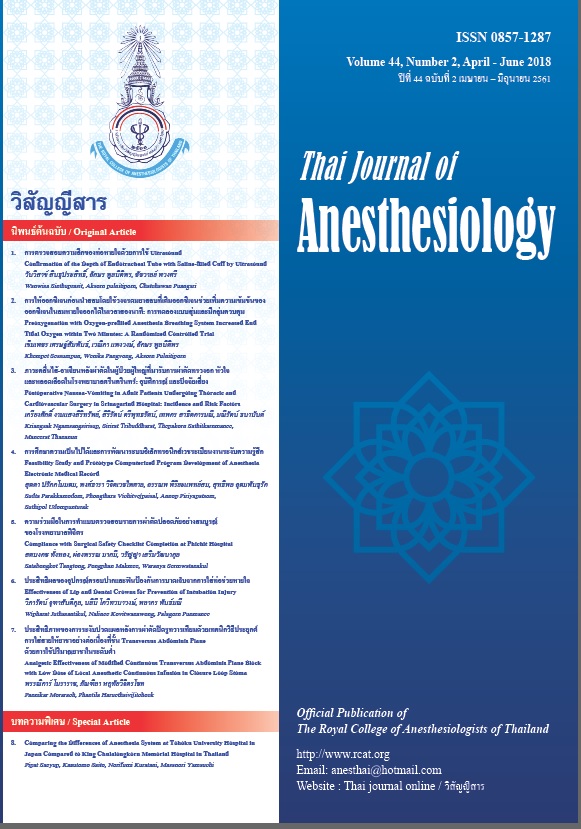Preoxygenation with Oxygen-prefilled Anesthesia Breathing System Increased End Tidal Oxygen within Two Minutes: A Randomized Controlled Trial
Main Article Content
Abstract
Background: One minute deep breathing technique is a widely accepted method for preoxygenation, especially in emergency situations. This is usually performed without prefilling oxygen in the anesthesia breathing system. Thus, the patient does not receive 100% oxygen initially.
Objective: The aim of this study was to compare the efficacy of deep breathing preoxygenation technique between oxygen-prefilled system and non-prefilled system.
Methods: Randomized controlled trial study was conducted on 40 adults undergoing elective surgery. The patients were randomly assigned into 2 groups, oxygen-prefilled group and non-prefilled group.
Results: The mean end-tidal oxygen (EtO2) at the first minute in oxygen-prefilled group was significantly higher than non-prefilled group (77.85 ± 4.64% vs. 66.95 ± 6.61%; p < 0.001). There were 15 patients (75%) in prefilled group and 7 patients (35%) in non-prefilled group with EtO2 ≥ 85%
at 2 minute which are significantly difference (p < 0.001).
Conclusions: Preoxygenation with oxygen-prefilled is more efficient than non-prefilled anesthesia breathing system. However, it still provided suboptimal preoxygenation. So, extending the duration of deep breathing at least 2 minutes using oxygen-prefilled system is recommended.
Article Details
References
2.
Biffen A, Hughes R. Apnoea and pre-oxygenation. Anaesthesia tutorial of the week [serial on the internet] 2013 Nov; 297:1-7. [cited 2013 Oct 4]; Available from: http://www.aagbi.org/sites/default /files/297%20Apnoea%20and%20
Pre-oxygenation.pdf
3.
Bouroche G, Bourgain JL. Preoxygenation and general anesthesia: a review. Minerva Anestesiol 2015;81(8):910-20.
4.
Tanoubi I, Drolet P, Donati F. Optimizing preoxygenation in adults. Can J Anaesth 2009;56(6):449-66.
5.
Nimmagadda U, Chiravuri SD, Salem MR, et al. Preoxygenation with tidal volume and deep breathing techniques: the impact of duration of breathing and fresh gas flow. Anesth Analg 2001;92(5): 1337-41.
6.
Nimmagadda U, Salem MR, Joseph NJ, Miko I. Efficacy of preoxygenation using tidal volume and deep breathing techniques with and without prior maximal exhalation. Can J Anesth 2007;54(6):448-52.
7.
GE healthcare. Advanced breathing system [Internet]. 2015. [cited 2015 Sep 9]; Available from: https://www3.gehealthcare.ae/en/products/categories/anesthesia_delivery/advanced_breathing_system#.
8.
Suntaranun P, Somprakit P, Lertarkayamanee J. Preuse checkup of anesthesia delivery system 1999. 1st ed. Bangkok: The royal college of anesthesiologists of Thailand; 1999. p 18-21.
9.
Baraka AS, Taha SK, El-Khatib MF, Massouh FM, Jabbour DG, Alameddine MM. Oxygenation using tidal volume breathing after maximal exhalation. Anesth Analg 2003;97(5):
1533-5.
10.
Mcgowan P, Skinner A. Preoxygenation-the importance of a good face mask seal. Br J Anaesth 1995;75(6):777-8.
11.
Berry CB, Myles PS. Preoxygenation in healthy volunteers: a graph of oxygen washin using end-tidal oxygraphy. Br J Anaesth 1994;72(1):116-8.


